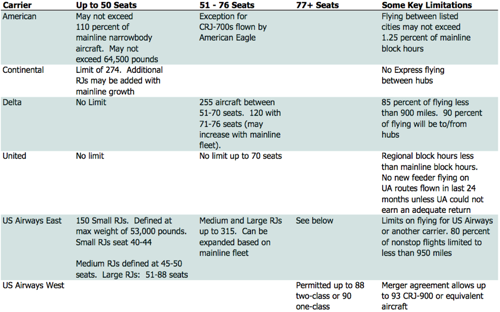Admittedly that oversimplifies things. All work groups (not just pilots) fit into that category and it includes more than just salary: benefits, retirement, work-rules, etc.
It is also unfair to point fingers. It isn't as if pilots will simply say "I'm not going to work here anymore because I don't get compensated on par with 100 seat pilots at brand X". That too is unrealistic.
What IS important is that you realize that there is nothing inherently efficient about operating a 35, 50, 70 seat jet. If anything, it is inefficient. The more passengers you carry, the lower the cost per seat mile. The most efficient aircraft are heavies flying full between mid-range city pairs. (provided the folks at yield management are doing their jobs)
If management thought they could get away with painting "RJ" on the tail of a 767 and have them flown by Chautauqua, they would do it in a heartbeat.
That's where your scope clauses come in. And they're not something that is ONLY negotiated at mainline. EVERY contract defines scope. That is the statement that defines who does what work.
Giving up ANY scope was, in my opinion, the WORST mistake that ALPA (or any other association) has made in their history. I don't care if it's a Cessna 150... it should be flown by Brand X with pilots from the Brand X system seniority list. Scope is jobs... and selling them for a pay-raise is short sightedness and greed at its very worst.
Starting from the bottom, every airline/union in the world gave up on scope in some way or fashion. In Canada, all across Europe and Asia most regional aircraft are flown by a contract carriers. It became the status quo worldwide. I believe all the US legacy unions in bankruptcy had guns to their head (as APA does now) and that's what unleashed the 700/900s and 170s into the sky.
There is plenty efficient about 70 seat aircraft. And there was plenty efficient about operating 35 and 50 seat aircraft until fuel prices went through the roof. It begins with the hub and spoke network. Market demand is market demand. If a market in the hub and spoke network calls for 35, 50 or 70 seat aircraft why would any logical business man want to put a 737 or MD80 on the route? If you're running a computer sales shop and selling 500 computers every 6 months are you going to order 2000 computers for your inventory? Now I know someone will interject with "just reduce frequency". Remember, this is a hub and spoke network that primarily targets high yielding business travelers that desire frequency. Also, increased frequency from a market increases connection possibilities at the hub and reduces layover time. More frequency=more efficient hub, in the hub and spoke model.
LCC carriers that operate just a couple or single type target lower yield customers and need a higher volume of passengers per plane for the business model to work. They fly much more of a point to point network between two cities whose market demand meet that aircraft size at a frequency is efficient and profitable.
The question in the regional industry is where do we go from here? We can sit here, ignore reality, and denounce and plans of AMR management while together with mainline pilots from much larger and profitable airlines with 250+ 51 seat or greater regional aircraft pat AMR pilots on the back and tell them to "hold the line" on scope. To me, that is illogical and out of touch with reality.
Where do we go from here? Well, the regional industry is near implosion. Mainline carriers have whipsawed the carriers into money bleeding contracts that were bid for just to live another day. Turns out for several regional carriers the last days are upon them and their is no other contracts available to extend life support any longer. If one of the bigger regionals collapses financially and shuts doors, it will have an impact much worse than the Comair strike. Mainline must pay the regionals more money to at least give them some sort of a healthy profit margin or they risk disaster.
Mainline pilots, just get the final key aircraft gauge(90 seat or greater) on property at economical rates and worry about pay-rates later. Negotiate shorter term contracts(seems like Fedex is getting a new contract and payraise every year) and include profit sharing. The best chance to get lucrative contracts is when the airline is running highly profitable and efficient. UPS, Fedex and SWA all got highly paid, industry leading contracts coming off highly profitable years. The future is bright in the airline industry, and I believe we have the right union leaders in place (especially at ALPA national) to make sure the future of the pilot profession is also bright.

